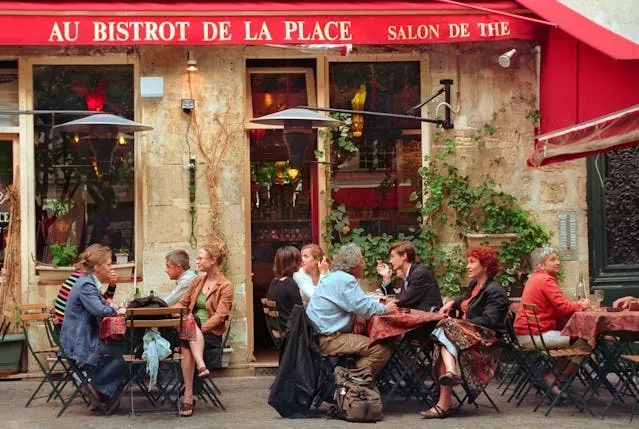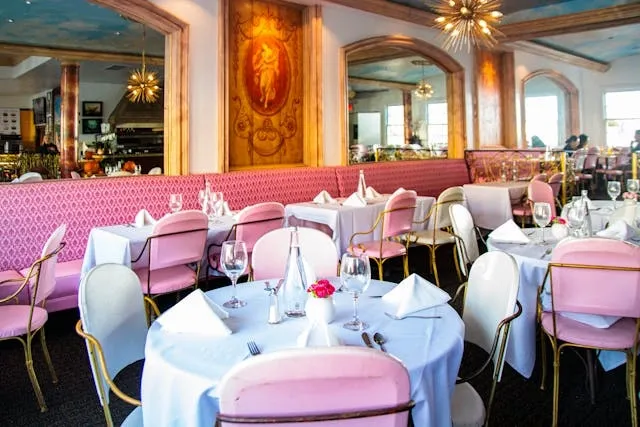French Table Setting: Step-By-Step Guide, Etiquettes, And Setup Ideas
A French table setting embodies elegance, attention to detail, and centuries of cultural tradition. Whether you’re preparing for a family dinner, a festive Parisian-inspired evening, or a formal banquet, master the French approach to create an atmosphere of sophistication.
In this guide to French style table setting, we share the essentials and how you can adapt them to your own dining room, bringing a touch of Paris to everyday gatherings. Learn general concepts as well as specific rules for cutlery, glasses, and plates.

Key Takeaways
- A French place setting emphasizes balance, etiquette, and hospitality, with varying setups for casual lunches, elegant dinners, and more.
- Proper French table setup follows structured cutlery and glassware placement, and etiquette rules guide utensil use, meal placing, and guest interaction.
- A French style dining experience values slower meals and meaningful conversion, and warmth and sophistication are key.
- We supply high-quality custom table covers that you can use to create the right aesthetic and a strong base for your French table setting.
Table of contents
-
French Table Setting
-
Step-By-Step Guide To Setting A French Table
-
How Does French Table Etiquette Compare To Other Cultures?
-
What Is The Difference Between French, American, And Russian Table Setups?
-
How Do You Choose The Right Tablecloth For A French Table?
-
How To Master French Table Etiquette
-
Essential Elements Of A French Table Setup
-
Where Does The Cutlery Go In A French Table Setup?
-
How Should You Arrange Glassware In A French Table Setting?
-
What Plates And Dishware Are Used In French Dining?
-
How Do You Create The Perfect French Table Centerpiece?
French Table Setting
A French table setting is unique because it blends etiquette with aesthetic refinement. Unlike casual dining, a French style table setting requires precision, whether for a Sunday lunch, Parisian-inspired soiree, or a formal dinner party.
Rules include:
- Forks are placed tines down
- Knives face inward
- Glasses follow a left-to-right sequence for wine, water, and champagne
- Napkins should be folded elegantly and placed either atop the plate or to the left
More than visual appeal, these details embody the French philosophy of dining. Meals are not rushed, but savored. Compared to dining table design ideas in other cultures, the French approach prioritizes etiquette as much as the beauty of custom table runners and other decorations.
Today, we find that many hosts adapt this style by incorporating Pinterest dining table inspiration to balance tradition with modern flair.

What Is French Style Dining?
French dining is about more than food - it’s a ritual that values pacing, atmosphere, and conversation. A French style table setting directly supports this tradition, organizing cutlery, plates, and glasses according to the multi-course meal structure.
Meals usually begin with an aperitif, followed by:
- Starters
- Mains
- Cheeses
- Desserts
Each will be accompanied by a carefully chosen wine.
In American dining, speed is often prioritized, but the French pace allows for lingering moments and meaningful dialogue. A Parisian table setting highlights hospitality by making every guest feel included, with the host guiding the flow of courses.
This cultural emphasis on respect and elegance explains why French dining traditions are admired worldwide. Replicating them is about more than just choosing the best table covers for events - you must explore ideas that value both practicality and refinement.
Step-By-Step Guide To Setting A French Table
Let’s look at the entire process of setting a French table. It starts with laying the tablecloth, then you need to place elements like plates, cutlery, and glassware, and decorate with an appropriate centerpiece.
Here are the steps in detail for a French table setup that can make even a casual meal feel like fine dining, blending etiquette with style..
Step 1: Lay The Tablecloth
You will need a crisp, properly-sized tablecloth to set the foundation. Look at a banquet tablecloth size chart and consider a drop length of 10-12 inches for the elegant, formal presentation you need.
Step 2: Place Plates
Dinner plates go at the center, and you should place a smaller bread plat to the top left to get the right arrangement for French dining.
Step 3: Arrange Cutlery
Forks go left, knives right with blades inward, and spoons on the far right. This matches the traditions and etiquette of French table setting.
Step 4: Position Glassware
You should have a water glass above the knives. The wine glasses, meanwhile, should be arranged in service order.
Step 5: Napkin Placement
Napkins must be folded neatly in the style of your choosing. A common mistake to avoid is to choose a basic fold - something more ornate is ideal. Then, place it either atop the plate or to the left.
Step 6: Add Centerpiece
Keep it low for conversation. Flowers or candles work well, or you could choose something more creative that adds a sense of opulence to the setup.
|
Step |
Task |
Key Details / Tips |
|
1 |
Lay the Tablecloth |
Use a crisp, properly-sized tablecloth. Check a banquet tablecloth size chart. Aim for a 10–12 inch drop for elegance and formality. |
|
2 |
Place Plates |
Center the dinner plate. Place a smaller bread plate at the top left. Ensures correct French dining arrangement. |
|
3 |
Arrange Cutlery |
Forks on the left, knives on the right with blades inward, spoons on the far right. Follows traditional French etiquette. |
|
4 |
Position Glassware |
Place water glass above knives. Arrange wine glasses in service order (white wine first, then red, then champagne). |
|
5 |
Napkin Placement |
Fold napkin neatly; ornate folds preferred. Place atop the plate or to the left. Avoid overly basic folds. |
|
6 |
Add Centerpiece |
Keep centerpiece low for conversation. Use flowers, candles, or creative décor to add elegance without obstruction. |
Need your own customized tablecloths?
When you work with us, you can create custom printed linen tablecloths to enhance a French table setting
How Does French Table Etiquette Compare To Other Cultures?
Table etiquette differs subtly across different cultures. These nuances become clear when you compare French place setting rules with American customs. In France, forks are placed tines down, signaling formality, while Americans typically place them upward. French dining emphasizes continued knife use, while it is common to switch hands in America.
Research shows that French meals emphasize formality, ritual, and multi-course structures. Guest interaction differs as well - French hosts guide conversation for balance and inclusivity whereas, in the U.S., measles may feel more relaxed. Compared with Russian traditions, French etiquette is less rigid in terms of service staff and timing.
These contrasts explain why understanding a French table setup is key for authentic hosting. By adopting these practices, you not only refine your dining table ideas but also show respect for an esteemed culinary tradition.
What Is The Difference Between French, American, And Russian Table Setups?
Each culture has distinct dining table design ideas rooted in history. Understanding these distinctions helps you adopt a French style table setting with accuracy, avoiding cultural missteps.
Let’s look at some differences in arrangements:
- French: Forks are positioned tines down on the left, knives inward on the right, and glasses aligned above the plate in drinking order.
- American: Forks are often placed tines up, and glassware placement may vary with less emphasis on progression.
- Russian: Elaborate settings are traditional, with multiple cutlery and glass options reflecting a highly formal dining place.
These variations may seem small, but they create entirely different atmospheres. According to studies, traditional Russian meals emphasize hospitality, and guests are expected to eat generously, whereas there is more freedom to stop eating at will in French and American customs.
Whether you’re replicating a Parisian table setting, or simply exploring ideas, knowledge of traditions enhances authenticity and elegance when hosting.

Add a personalized table skirt to your tables
Give your French table setting a little extra style with a custom table skirt.
Explore optionsHow Do You Choose The Right Tablecloth For A French Table?
The tablecloth is the canvas of a French table setup. A well-fitted cloth establishes elegance and symmetry, ensuring chairs slide easily and the table appears refined. For everyday dining, white or ivory linen creates a timeless base, while patterned cloths - like Provenance-inspired florals - add regional charm.
When planning your French dinner table setting, the cloth should drape evenly. An overhang of 8-12 inches on all sides is about right. Material matters too, so consider the following:
- Linen or cotton for formal events
- Cotton blends for casual use
- Polyester for a versatile solution
If you are seeking authenticity, muted colors suit formal dinners, while lighter pastels feel inviting at brunch. To achieve the perfect look, our online store offers custom digital print tablecloths tailored to fit your table dimensions to ensure your French-style dining setup is cohesive, polished, and true to tradition.
How To Master French Table Etiquette
French dining etiquette extends beyond cutlery placement - it reflects values of hospitality and refinement. To master it, begin by pacing your meal appropriately. Courses should flow naturally without rushing.
Guests are served from the left and cleared from the right, reinforcing structure. Utensil signals matter too - parallel utensils indicate a finished plate, while crossed utensils suggest a pause. In French dinner table setting, hosts guide the conversation to ensure inclusivity.
Do: Keep elbow off the table, wait for the host to start, and use bread plates correctly. Don’t:
- Cut salad with a knife
- Leave napkins on the chair
Observe these rules to ensure your French style table setting becomes more than decor, like considering table runners vs tablecloths. It should be a cultural experience aligned with authentic dining room table designs.
Need to adorn a rectangular table with a covering?
We can create custom rectangle tablecloths in any style to enhance your French table setting.
Essential Elements Of A French Table Setup
A true French table setup relies on essential elements that blend functionality with elegance. At the foundation are high-quality plates. This usually means a dinner plate, a side plate, and often a charger for formality.
Cutlery placement follows the outside-in principle. Forks go on the left, knives on the right, and dessert utensils above. Glassware is equally vital, and you should have separate glasses for:
- Water
- White wine
- Red wine
- Champagne
Your custom linen beverage napkins must be folded with care to highlight refinement. These essentials aren’t just practical - they are visual cues that communicate hospitality. When choosing dining table design ideas, invest in durable, elegant dishware and glassware that can stand up to frequent use.
A decorated dining table in the French style highlights beauty but also emphasizes thoughtful detail. This ensures every guest feels welcomed into an atmosphere of charm and sophistication.
Where Does The Cutlery Go In A French Table Setup?
Cutlery placement is an iconic hallmark of a proper French table setup. The sequence reflects the outside-in principle, whereby the outermost utensils are used first as courses progress.
Here’s a guide:
- Forks: These go on the left, tines facing down. This is a tradition that signals refinement.
- Knives: Place these to the right of the plate, blades turned inward to symbolize courtesy.
- Spoons: When included, these are placed farthest right.
With this structured placement, you ensure smooth dining without confusion. Compared with American dining table ideas, where forks are tines-up, the French orientation stands out for its formal appearance. Learn these details to elevate your hosting and create an authentic French place setting that blends etiquette with timeless design.
Add personalized table runners to multiple tables
Need a French table setting on multiple tables for an event? Order custom bulk table runners from us for a personalized touch.
Get startedHow Should You Arrange Glassware In A French Table Setting?
In a French dinner table setting, glassware arrangement is both functional and aesthetic. Starting above the knives, the water glass anchors the setup, followed by wine glasses placed diagonally to the right in order of service - white wine before red wine. Champagne flutes are often added as well.
This sequence ensures clarity for both the host and the guest as the meal progresses from one course to the next. Whether you choose crystal elegance stemless wine glasses or different styles, they are usually arranged from largest to smallest for a sense of balance and symmetry. Modern hosts may want to simplify by offering fewer glasses, but adhering to this tradition adds sophistication.
When exploring dining table ideas, selecting fine glassware enhances both flavor and presentation. Ultimately, a French table setup uses glassware not only for practicality but also to reinforce the elegance and formality of the dining experience.
What Plates And Dishware Are Used In French Dining?
Plates in a French table setup serve specific purposes aligned with the structure of the meal. Investing in versatile dishware ensures your French dinner table setting remains adaptable, elegant, and welcoming.
Let’s look at the key considerations:
- The charger, or “sous-plat”, anchors the arrangement and is not usually used for food.
- Dinner plates go atop the charger, with smaller appetizer or salad plates as needed.
- Bread plates sit to the upper left, often paired with a small butter knife.
French dining may also feature porcelain or ceramic pieces with regional patterns, such as Provençal designs. Seasonal dishware variations reflect the event - lighter colors are preferred for spring, and deeper tones for winter. When curating a Parisian table setting, consistency of material and pattern is important for cohesion, and tablecloths are still used to complement this.
Pay heed to these principles whether for family dinners or festive Parisian-inspired celebrations.

How Do You Create The Perfect French Table Centerpiece?
A French style table setting is never complete without a tasteful centerpiece. Traditionally, arrangements are kept low to preserve eye contact and conversation across the table. The key is balance - the centerpiece should enhance without overwhelming.
Let’s look at some French table setting ideas for centerpieces:
- Fresh flowers: Options like roses, lavender, and peonies are popular, especially when paired with glass vases or rustic pottery.
- Seasonal considerations: Autumn leaves or winter candles can add a touch of charm.
- Parisian table settings: Antique elements like candlesticks or silver trays may be incorporated to reflect elegance.
Today, many of our customers turn to Pinterest to find inspiration for creative arrangements that combine modern and traditional touches. Whether rustic, minimalist, or luxurious, a thoughtfully chosen centerpiece ensures your French-style dining setup feels cohesive. Our custom size tablecloths might just enhance the aesthetic further as well.
Frequently Asked Questions About French Table Setting
What Is A French Table Setting?
A French table setup follows structured placement rules for cutlery, plates, and glasses, designed to enhance multi-course dining.
How Do You Set A Table In The French Style?
Begin with a tablecloth, then arrange plates, cutlery (forks left, knives right), and glasses above the plate in order of use. Add napkins and a tasteful centerpiece for refinement.